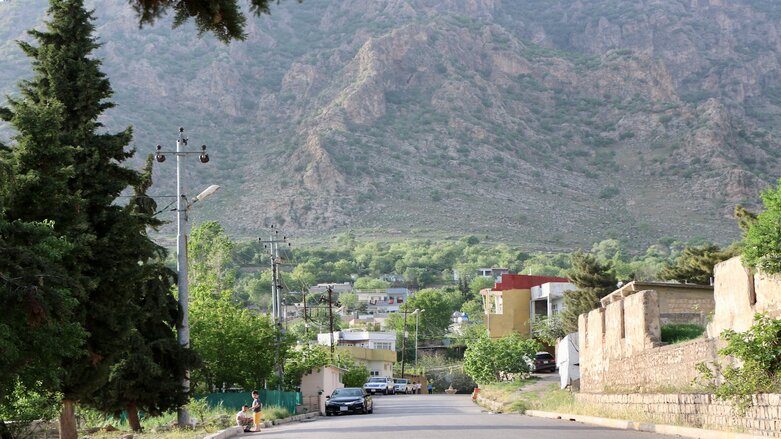Bamarni, a village with a rich history
Bamarni has archeological sites that are up to 6,000 years old.

Bamarni is a village at the heart of Metina mountain range in the Kurdistan Region's Duhok province.
Bamarni is in the center of the eponymous subdistrict, located 60 kilometers from the city of Duhok. It has water springs and oak trees.
In February 2000, Bamarni officially became the center of the subdistrict in the Amedi district as demanded by its population.
Many important historical figures came from Bamarni.
According to Kurdish historian Karzan Muhammed Hussein, an expert on the area, there's a commonly held opinion that the town's name originates from the Kurdish word ‘Ba Mirni’, which literally means "wind of the death".
In the 1600 and 1700s, the area was devastated by famines and plagues. To this day, there are remnants of graveyards from those dark times.
The other opinion, expressed by historians like Jamal Baban, is that the name of Bamarni came from Aramaic languages (Beth Morni or Beth Hardni) and means 'the fortified house', a likely reference to the geographically fortified location of Bamarni at the foot of the mountains.

Bamarni has archeological sites that are up to 6,000 years old. In 1971, Othman Khaled, an engineer from Bamarni, took a piece of lime from the 'Qasra Kafiri' remains of one of the archeological buildings in a Bamarni neighborhood to the United States to examine. Analysis showed a mixture of manmade and natural components that could be up to 6,000-years-old.
Qasra Kafira, which is Kurdish for 'Infidel's Palace', is a registered archeological site by the Nineveh antiquities directorate.
What differentiates the demography of Bamarni from other Kurdish villages and towns is that for a very long time it was home to people from different Kurdish tribes, especially during the Ottoman era. As a result, its population is significantly more mixed than many other areas.
It used to have a Jewish community before they all left for Israel. Still, even now, there are remains of Jewish houses inside Bamarni, such as Manahem house, Moshi, Ori, and Tog houses.

There also used to be Christian families in Bamarni dating back to the 10th century. Manuscripts have mentioned a bishop named Shimdi of the Bamarni diocese. Even today, a number of Christians live in some nearby villages.
Nawsk, a carved rock with arched gates and five stone beds inside, is another archaeological site in Bamarni which is 2,000-years-old.
It was first registered by the Iraqi government antiquities authority in 1952 as an archeological site, along with 37 other sites in the Amedi district.
With no sources available, historians' opinions on Nawsk vary. Some believe it could be a Zoroastrian temple or a seclusion site for devoted Christians. It has some noticeable Roman architectural features.
Jamala cave is another ancient site believed to have once been a Zoroastrian temple.
Bamarni has been a famous educational center in the region. In 1846, Sheikh Muhammed Tahiri, with help from the people of Bamarni, built a Tekke, a place used for teaching religion and Naqshabandi Sufism. Back then, Tekkes were important places of education.
This made Bamarni an educational hub for the surrounding areas.
In 1922, the first school was opened in Bamarni by the government. Haj Mohammed Saeed Mullah Yaseen was appointed its headmaster. He is known as "the first instructor" in the area.
Having influential sheikhs was a focal point for Bamarni and the area in general because sheikhs usually had people's reverence and could, therefore, represent them to the rulers. They visited Istanbul to meet with the sultan during the era of the Ottoman Empire.
When Iraq was a kingdom, King Faisal visited the region in 1923 and stayed in a Tekke in Bamarni, where he met with Sheikh Bahaaddin. Other royal visits followed in 1933 and 1957, the historian Hussein told Kurdistan 24.
According to the 1957 Iraqi census, Barmarni had a population of 2,509. In 1931, author Ali Saido Gorani mentioned that there was a school and three mosques in Bamarni.

Many Kurdish patriots willing to make great sacrifices came from Barmarni. As a result, Bamarni suffered many hardships, especially during the Kurdish revolutions.
People of Bamarni had to abandon their homes several times, including in 1963, 1974, and 1987-1991, fleeing the oppression and violence of past Iraqi regimes against the Kurds. As of 2014, the town had a population of 1,957.
Bamarni has preserved most of its natural environment. As a result, it remains a beautiful and peaceful site for tourists in all seasons of the year.
